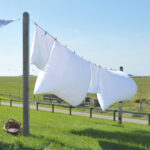Focus on the drain holes
Where does water leave your home (or business) and flow to the sewer? Most water-saving tips focus on the faucet. I’m encouraging you to focus as well on where the water goes, where it leaves your home.
In most homes, that includes:
- (a) each toilet,
- (b) the kitchen sink,
- (c) perhaps a dishwasher,
- (d) perhaps a clothes washer,
- (e) showers / bathtubs,
- (f) bathroom sinks,
- (g) perhaps an auxiliary sink such as laundry room or bar.
a-b-c are blackwater (defined here). Because these types of wastewater can harbor pathogens that can make people sick, these types of wastewater demand special treatment — it’s not super simple. Referring to my previous post, all you can do about blackwater is #2 changing out devices, #5 volume control, or #6 let it mellow.
d … In the few special cases where you are washing diapers, or washing articles from people who have infectious diseases, clothes washer water must be treated as blackwater. But MOST of our laundry doesn’t fall into that category. Most of our laundry water can be used as greywater (defined here).
a-c-d are prime candidates for upgrading your household appliances to low-use, low-flow.
a … is a place for Habit Change (#6 let it mellow ), no matter where you live, whether that’s house, rental, condo, or apartment.
b-e-f-g should all receive low-flow aerators installed on the faucet head, a very quick and inexpensive add-on.
b-e-f-g are places for Habit Change (#5 volume control), no matter where you live, whether that’s house, rental, condo, or apartment.
d-e-f-g are possibilities to redirect to greywater systems, if your plumbing design permits.
b-e-f-g are all great candidates for bucketting, no matter where you live, whether that’s house, rental, condo, or apartment.
Here’s the challenge: How many times can you use d-e-f-g water before it leaves your property?
8 tips for even deeper water savings


